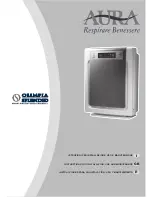
18
ENGLISH
10.5. Airtight test and evacuation, refrigerant charging
1
Airtight test
Perform with the stop valve of the outdoor unit closed, and pressurize the connection piping and the indoor unit from the service port provided on the
stop valve of the outdoor unit. (Always pressurize from both the liquid pipe and the gas pipe service ports.)
A
Nitrogen gas
B
To indoor unit
C
System analyzer
D
Lo Knob
E
Hi Knob
F
Ball valve
G
Liquid pipe
H
Gas pipe
I
Outdoor unit
J
Service port
The method of conducting the airtight test is basically the same as for older models. However, since the restrictions have a large affect on deterioration
of the refrigerator oil, always observe them. Also, with nonazeotropic refrigerant (R407C, etc.), gas leakage causes the composition to change and
affects performance. Therefore, since the entire amount must be replaced if gas leakage occurs, perform the airtightness test cautiously.
Restriction
• If a flammable gas or air (oxygen) is used as the pres-
surization gas, it may catch fire or explode.
• Do not use a refrigerant other than that indicated on the
unit.
• Sealing with gas from a cylinder will cause the composi-
tion of the refrigerant in the cylinder to change.
• Use a pressure gauge, charge box, and other parts es-
pecially for R407C.
• An electric leak detector for R22 cannot detect leaks.
• Do not use a haloid torch. (Leaks cannot be detected.)
Airtight test procedure
1. Nitrogen gas pressurization
(1) After pressurizing to the design pressure (2.98 MPa) using nitrogen gas, let stand
for about one day. If the pressure does not drop, airtightness is good.
However, if the pressure drops, since the leaking point is unknown, the following
bubble test may also be performed.
(2) After the pressurization described above, spray the flare connection parts, brazed
parts, flanges, and other parts that may leak with a bubbling agent (Kyuboflex,
etc.) and visually check for bubbles.
(3) After the airtight test, wipe off the bubbling agent.
2. Pressurization using refrigerant gas and nitrogen gas
(1) After sealing with liquid R407C from a cylinder and pressurizing to a gas pressure
of approximately 0.2 MPa, pressurize to the design pressure (2.98 MPa) using
nitrogen gas.
However, do not pressurize at one time. Stop during pressurization and check that
the pressure does not drop.
(2) Check for gas leaks by checking the flare connection parts, brazed parts, flanges,
and other parts which may leak using an R407C compatible electric leak detector.
(3) This test may be used together the with bubble type gas leak test.
D
C
C
B
E
F
G
H
I
J
A
LO
HI
Caution:
Do not use a refrigerant other than R407C.
- If a refrigerant (R22, etc,) other than R407C is used, the chlorine in the refrigerant will cause the refrigerator oil to deteriorate.
LO
HI
Summary of Contents for CITY MULTI PUHY-P-YMF-B
Page 37: ...37 ENGLISH ...
Page 73: ...73 DEUTSCH ...
Page 109: ...109 FRANÇAIS ...
Page 145: ...145 NEDERLANDS ...
Page 181: ...181 ITALIANO ...
Page 182: ......
Page 183: ......
















































